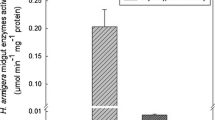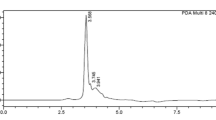Abstract
Pectolinaringenin was isolated from chloroform extract of Clerodendrum phlomidis L. and was evaluated at 12.5 to 100 ppm concentrations for its effects on total protein, esterase and glutathione S-transferase (GST) activities of Earias vittella and Helicoverpa armigera. At 100 ppm, the compound reduced total protein content by 55.75% and 53.01% over control with IC50 values of 74.37 and 212.31 ppm in E. vittella and H. armigera, respectively. At 100 ppm it also reduced GST and esterase enzyme activities in E. vittella by 37.53% and 43.09% over control, with IC50 values of 133.00 and 111.76 ppm, respectively. It also reduced GST and esterase activities in H. armigera by 43.14% and 47.421% over control with IC50 values of 114.38 and 98.78 ppm, respectively. Data were analyzed for their normality using the Shapiro-Wilk test and Levene’s statistics to determine the significant deviation. Pectolinaringenin could be used for the management of agricultural pests.

Similar content being viewed by others
References
Baskar, K., & Ignacimuthu, S. (2012). Antifeedant, larvicidal and growth inhibitory effect of ononitol monohydrate isolated from Cassia tora L. against Helicoverpa armigera (Hub.) and Spodoptera litura (Fab.) (Lepidoptera: Noctuidae). Chemosphere, 88, 384–388.
Birk, Y., & Peri, I. (1980). Saponins. In I. E. Liener (Ed.), Toxic constituents of plant foodstuff (2nd ed., pp. 161–182). New York, NY: Academic Press.
Boreddy, Y., Chitra, K. C., & Reddy, E. (2000). Studies on sublethal concentration (LC30) of Annona seed extract on total proteins of Spodoptera litura (Fab.). Entomon, 25, 351–355.
Bradford, M. M. (1976). A rapid and sensitive method for the quantitation of microgram quantities of protein utilising the principle of protein-dye binding. Analytical Biochemistry, 72, 248–254.
Bullangpoti, V., Visetson, S., Milne, J., Milne, M., Sudthongkong, C., & Pornbanlualap, S. (2007). Effects of alpha-mangostin from mangosteen pericarp extract and imidacloprid on Nilaparvata lugens (Stål.) and non-target organisms: toxicity and detoxification mechanisms. Communications in Agricultural and Applied Biological Sciences, 72, 361–712.
Bullangpoti, V., Visetson, S., Milne, J., & Pornbanlualap, S. (2004). Effects of mangosteen’s peels and rambutan’s seeds on toxicity, esterase and glutathione-S-transferase in rice weevil (Sitophilus oryzae L.). Kasetsart Journal: Natural Science, 38, 84–89.
Cho, J. R., Kim, H. S., Song, H. S., & Lee, J. D. (1995). Synergism and detoxification mechanism in the larvae of Helicoverpa assulta and Spodoptera litura (pp. 413–431). Crops: USDA Research Reports of the Rural Development Administration.
Conyers, C. M., MacNicoll, A. D., & Price, N. R. (1998). Purification and characterisation of an esterase involved in resistance to organophosphorus insecticides in the saw toothed grain beetle, Oryzaephilus surinamensis, (Coleoptera: Silvernidae). Insect Biochemistry and Molecular Biology, 28, 435–448.
Elliger, C. A., Chan, B. C., & Waiss, A. C., Jr. (1980). Flavonoids as larval growth inhibitors. Naturwissenschaften, 67, 358–360.
Fakrudin, B., Kumar, V., Krishnareddy, K. B., Patil, B. V., & Kuruvinashetti, M. S. (2004). Insecticide resistance vis-à-vis Cry1Ac delta endotoxin resistance in South Indian cotton ecosystem. Resistant Pest Management Newsletter, 13, 15–17.
Finney, D. J. (1971). Probit analysis (3rd ed.). London, UK: Cambridge University Press.
Francis, F., Haubruge, E., Gaspar, C., & Dierickx, P. J. (2001). Glutathione S-transferases of Aulacorthum solani and Acyrthosiphon pisum: Partial purification and characterisation. Comparative Biochemistry and Physiology Part B, 129, 165–171.
Han, Z., Moores, G., Devonshire, A., & Denholm, I. (1998). Association between biochemical markers and insecticide resistance in the cotton aphid, Aphis gossypii. Pesticide Biochemistry and Physiology, 62, 164–171.
Hedin, P. A., & Waage, S. K. (1986). Roles of flavonoids in plants resistant to insects. In V. Cody, E. Middleton, & J. B. Harborne (Eds.), Plant flavonoids in biology and medicine: Biochemical, pharmacological and structure activity relationships (pp. 87–100). New York, NY: Alan R. Liss Inc.
Huang, S., & Han, Z. (2007). Mechanisms for multiple resistances in field populations of common cutworm, Spodoptera litura (Fabricius) in China. Pesticide Biochemistry and Physiology, 87, 14–22.
Jalali, S. K., Mohan, K. S., Singh, S. P., Manjunath, T. M., & Lalitha, Y. (2004). Baseline susceptibility of the old-world bollworm, Helicoverpa armigera (Hübner) (Lepidoptera: Noctuidae) population from India to Bacillus thuringiensis Cryl Ac insecticides protein. Crop Protection, 23, 53–59.
Jallow, M. F. A., Cunningham, J. P., & Zalucki, M. P. (2004). Intraspecific variation for host plant use in Helicoverpa armigera (Hübner) (Lepidoptera: Noctuidae): Implications for management. Crop Protection, 23, 955–964.
Jayabalan, D., & Murugan, K. (1997). Effect of neem limonoids on feeding and reproduction of Helicoverpa armigera (Hübner) (Lepidoptera: Noctuidae). Entomon, 22, 15–20.
Jayaraj, S. (2003). Insect biodiversity: Conservation and enhancement of entomophage diversity for biological pest suppression in rice ecosystem. In S. Ignacimuthu & S. Jayaraj (Eds.), Biological control of insect pests (pp. 232–249). New Delhi, India: Phoenix Publishing House.
Khalaf, A. A. (1998). Biochemical and physiological impacts of two volatile plants oils on Muscina stabulans (Diptera: Muscidae). Journal of the Egyptian-German Society of Zoology, 27, 315–329.
Kim, J. S., Kwon, C. S., & Son, K. H. (2000). Inhibition of ά-glucosidase and ά-amylase by luteolin, a flavonoid. Bioscience, Biotechnology, and Biochemistry, 64, 2458–2461.
Koul, O., Shankar, J. S., Mehta, N., Taneja, S. C., Tripathi, A. K., & Dhar, K. L. (1997). Bioefficacy of crude extracts of Aglaia species (Meliaceae) and some active fractions against lepidopteran larvae. Journal of Applied Entomology, 121, 245–248.
Lu, M., Wu, W., & Liu, H. (2008). Effect of celangulin V on detoxification enzymes in Mythimna separata and Agrotis ypsilon. Pesticide Biochemistry and Physiology, 90, 114–118.
Mukanganyama, S., Figueroa, C. C., Hasler, J. A., & Niemeyer, H. M. (2003). The effect of DIMBOA on detoxification enzymes of the aphid Rhopalosiphum padi (Homoptera: Aphididae). Journal of Insect Physiology, 49, 223–229.
Muthu, C., Baskar, K., Kingsley, S., & Ignacimuthu, S. (2012a). Bioefficacy of Clerodendrum phlomidis Linn. F. and Flueggea leucopyrus (Koen.) Willd. against Earias vittella Fab. Journal of Entomology, 9, 332–342.
Muthu, C., Reegan, A. D., Kingsley, S., & Ignacimuthu, S. (2012b). Larvicidal activity of pectolinaringenin from Clerodendrum phlomidis L. against Culex quinquefasciatus Say and Aedes aegypti L. (Diptera: Culicidae). Parasitology Research, 111, 1059–1065.
Neoliya, N. K., Singh, D., & Sangwan, R. S. (2007). Azadirachtin-based insecticides induce alteration in Helicoverpa armigera Hub. head polypeptides. Current Science, 92, 94–99.
Oppenoorth, F. J. (1979). Glutathione-S-transferase and hydrolytic activity in a tetrachlorvinphos-resistant strain of house fly and their influence on resistance. Pesticide Biochemistry and Physiology, 11, 176–178.
Radake, S. G., & Undirwade, R. S. (1981). Seasonal abundance and insecticidal control of shoot and fruit borer, Earias spp. on okra, Abelmoschus esculentus (L.). Indian Journal of Entomology, 43, 283–287.
Renuga, F. B., & Sahayaraj, K. (2009). Influence of botanicals in total head protein of Spodoptera litura (Fab.). Journal of Biopesticides, 2, 52–55.
Rharrabe, K., Bakrim, A., Ghailani, N., & Sayah, F. (2007). Bioinsecticidal effect of harmaline on Plodia interpunctella development (Lepidoptera: Pyralidae). Pesticide Biochemistry and Physiology, 89, 137–145.
Schmidt, G. H., Rembold, H., Ahmed, A. A. I., & Breuer, M. (1998). Effect of Melia azedarach fruit extract on juvenile hormone titer and protein content in the haemolymph of two species of noctuid lepidopteran larvae (Insecta: Lepidoptera: Noctuidae). Phytoparasitica, 26, 283–292.
Senthil Nathan, S., Choi, M. Y., Paik, C. H., Seo, H. Y., Kalaivani, K., & Kim, J. D. (2008). Effect of azadirachtin on acetylcholinesterase (AChE) activity and histology of the brown planthopper Nilaparvata lugens (Stål). Ecotoxicology and Environmental Safety, 70, 244–250.
Senthilkumar, N., & Murugan, K. (1999). Impact of NPV and azadirachtin on the digestive enzyme activity and biochemical composition of the gut of Helicoverpa armigera Hübner (Insecta: Lepidoptera: Noctuidae). Tropical Agricultural Research, 11, 393–407.
Shekari, M., Sendi, J. J., Etebari, K., Zibaee, A., & Shadparvar, A. (2008). Effects of Artemisia annua L. (Asteracea) on nutritional physiology and enzyme activities of elm leaf beetle, Xanthogaleruca luteola Mull (Coleoptera: Chrysomellidae). Pesticide Biochemistry and Physiology, 91, 66–74.
Sieber, K. P., & Rambold, H. (1983). The effects of azadirachtin on the endocrine control of moulting in Locusta migratoria. Journal of Insect Physiology, 29, 523–527.
Singleton, V. L. (1981). Naturally occurring food toxicants: Phenolic substances of plant origin common in foods. Advances in Food Research, 27, 149–242.
Sinha, S. N., Sharma, S. P., & Chakrabarti, A. K. (1978). Effect of spotted bollworm infestation on seed quality of okra. Seed Research, 6, 161–164.
Sintim, H. O., Tashiro, T., & Motoyama, N. (2009). Response of the cutworm Spodoptera litura to sesame leaves or crude extracts in diet. Journal of Insect Science, 9, 1–13.
Sosa, M. E., Tonn, C. E., Guerreiro, E., & Giordano, O. S. (2000). Bioactividad de flavonoides sobre larvas de Tenebrio monitor. Revista de la Sociedad Entomológica Argentina, 59, 179–184.
Sree, K. S., & Padmaja, V. (2008). Oxidative stress induced by destruxin from Metarhizium anisopliae (Metch.) involves changes in glutathione and ascorbate metabolism and instigates ultrastructural changes in the salivary glands of Spodoptera litura (Fab.) larvae. Toxicon, 51, 1140–1150.
Srinivasan, P. M., & Gowder, R. B. (1960). A preliminary note on the control of bhendi shoot and fruit borer. Indian Journal of Agricultural Sciences, 30, 57.
Subramanian, S., & Mohankumar, S. (2006). Genetic variability of the bollworm, Helicoverpa armigera, accruing on different host plants. Journal of Insect Science, 6, 26.
Thiboldeaux, R. L., Lindroth, R. L., & Tracy, J. W. (1998). Effects of juglone (5-hydroxy-1,4- naphthoquinone) on midgut morphology and glutathione status in Saturniid moth larvae. Comparative Biochemistry and Physiology, 120, 481–487.
Whitaker, J. R. (1981). Naturally occurring peptide and protein inhibitors of enzymes. In J. C. Ayres & J. Kirschman (Eds.), Impact of toxicology on food processing (pp. 57–104). Westport, CT, USA: Avi Publishing.
Wood, E., Casabe, N., Melgar, F., & Zerba, E. (1986). Distribution and properties of glutathione-S-transferase from Triatoma infestans. Comparative Biochemistry and Physiology, 84, 607–618.
Wood, E. J., Melgar, F., & Zerba, E. N. (1990). Inhibitors of the glutathione S-transferases from Triatoma infestans. Anales de la Asociacion Quimica Argentina, 78, 251–260.
Zanden, J. J. V., Geraets, S., Wortelbier, H. M., Bladeren, P. J. V., Rietjens, I. M. C. M., & Cnubben, N. H. P. (2004). Structural requirements for the flavonoid mediated modulation of glutathione S-transferase P1-1 and GS-X pump activity in MCF-7 breast cancer cells. Biochemical Pharmacology, 67, 1607–1617.
Zibaee, A., & Bandani, A. R. (2010a). Effects of Artemisia annua L. (Asteracea) on digestive enzymes profiles and cellular immune reactions of the sunn pest, Eurygaster integriceps (Heteroptera: Scutellaridae), against Beauvaria bassiana. Bulletin of Entomological Research, 100, 185–196.
Zibaee, A., & Bandani, A. R. (2010b). A study on the toxicity of a medicinal plant, Artemisia annua L. (Asteracea) extracts to the sunn pest, Eurygaster integriceps Puton (Heteroptera: Scutelleridae). Journal of Plant Protection Research, 50, 48–54.
Zucker, W. V. (1983). Tannins: Does structure determine function? An ecological perspective. American Naturalist, 121, 335–365.
Acknowledgment
The authors thank Entomology Research Institute, Loyola College, India, for financial support.
Author information
Authors and Affiliations
Corresponding author
Rights and permissions
About this article
Cite this article
Baskar, K., Muthu, C. & Ignacimuthu, S. Effect of pectolinaringenin, a flavonoid from Clerodendrum phlomidis, on total protein, glutathione S-transferase and esterase activities of Earias vittella and Helicoverpa armigera . Phytoparasitica 42, 323–331 (2014). https://doi.org/10.1007/s12600-013-0363-4
Received:
Accepted:
Published:
Issue Date:
DOI: https://doi.org/10.1007/s12600-013-0363-4




